Baosong Yang
additional authors not shown
Sampling-Efficient Test-Time Scaling: Self-Estimating the Best-of-N Sampling in Early Decoding
Mar 03, 2025Abstract:Test-time scaling improves large language model performance by adding extra compute during decoding. Best-of-N (BoN) sampling serves as a common scaling technique, broadening the search space for finding better solutions from the model distribution. However, traditional BoN requires N full generations, leading to high GPU memory overhead and time latency. Moreover, some methods depend on reward models, adding computational cost and limiting domain generalization. In this paper, we propose Self-Truncation Best-of-N (ST-BoN), a novel decoding method that avoids fully generating all samplings and eliminates the need for reward models. ST-BoN introduces early sampling consistency to estimate the most promising sample, truncating suboptimal ones to free memory and accelerate inference. This pushes the sampling-efficient test-time scaling. Compared to traditional BoN, ST-BoN can reduce dynamic GPU memory overhead by over 90% and time latency by 50%, while achieving comparable or even better performance across reasoning and open-ended domains.
MinMo: A Multimodal Large Language Model for Seamless Voice Interaction
Jan 10, 2025



Abstract:Recent advancements in large language models (LLMs) and multimodal speech-text models have laid the groundwork for seamless voice interactions, enabling real-time, natural, and human-like conversations. Previous models for voice interactions are categorized as native and aligned. Native models integrate speech and text processing in one framework but struggle with issues like differing sequence lengths and insufficient pre-training. Aligned models maintain text LLM capabilities but are often limited by small datasets and a narrow focus on speech tasks. In this work, we introduce MinMo, a Multimodal Large Language Model with approximately 8B parameters for seamless voice interaction. We address the main limitations of prior aligned multimodal models. We train MinMo through multiple stages of speech-to-text alignment, text-to-speech alignment, speech-to-speech alignment, and duplex interaction alignment, on 1.4 million hours of diverse speech data and a broad range of speech tasks. After the multi-stage training, MinMo achieves state-of-the-art performance across various benchmarks for voice comprehension and generation while maintaining the capabilities of text LLMs, and also facilitates full-duplex conversation, that is, simultaneous two-way communication between the user and the system. Moreover, we propose a novel and simple voice decoder that outperforms prior models in voice generation. The enhanced instruction-following capabilities of MinMo supports controlling speech generation based on user instructions, with various nuances including emotions, dialects, and speaking rates, and mimicking specific voices. For MinMo, the speech-to-text latency is approximately 100ms, full-duplex latency is approximately 600ms in theory and 800ms in practice. The MinMo project web page is https://funaudiollm.github.io/minmo, and the code and models will be released soon.
Qwen2.5 Technical Report
Dec 19, 2024Abstract:In this report, we introduce Qwen2.5, a comprehensive series of large language models (LLMs) designed to meet diverse needs. Compared to previous iterations, Qwen 2.5 has been significantly improved during both the pre-training and post-training stages. In terms of pre-training, we have scaled the high-quality pre-training datasets from the previous 7 trillion tokens to 18 trillion tokens. This provides a strong foundation for common sense, expert knowledge, and reasoning capabilities. In terms of post-training, we implement intricate supervised finetuning with over 1 million samples, as well as multistage reinforcement learning. Post-training techniques enhance human preference, and notably improve long text generation, structural data analysis, and instruction following. To handle diverse and varied use cases effectively, we present Qwen2.5 LLM series in rich sizes. Open-weight offerings include base and instruction-tuned models, with quantized versions available. In addition, for hosted solutions, the proprietary models currently include two mixture-of-experts (MoE) variants: Qwen2.5-Turbo and Qwen2.5-Plus, both available from Alibaba Cloud Model Studio. Qwen2.5 has demonstrated top-tier performance on a wide range of benchmarks evaluating language understanding, reasoning, mathematics, coding, human preference alignment, etc. Specifically, the open-weight flagship Qwen2.5-72B-Instruct outperforms a number of open and proprietary models and demonstrates competitive performance to the state-of-the-art open-weight model, Llama-3-405B-Instruct, which is around 5 times larger. Qwen2.5-Turbo and Qwen2.5-Plus offer superior cost-effectiveness while performing competitively against GPT-4o-mini and GPT-4o respectively. Additionally, as the foundation, Qwen2.5 models have been instrumental in training specialized models such as Qwen2.5-Math, Qwen2.5-Coder, QwQ, and multimodal models.
P-MMEval: A Parallel Multilingual Multitask Benchmark for Consistent Evaluation of LLMs
Nov 14, 2024
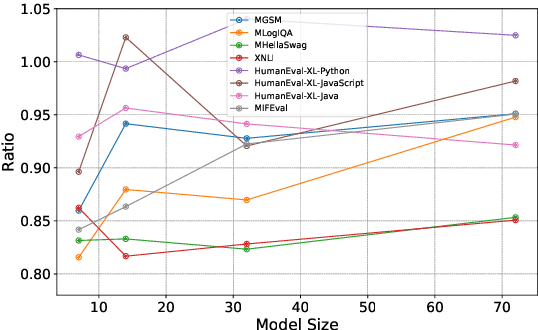


Abstract:Recent advancements in large language models (LLMs) showcase varied multilingual capabilities across tasks like translation, code generation, and reasoning. Previous assessments often limited their scope to fundamental natural language processing (NLP) or isolated capability-specific tasks. To alleviate this drawback, we aim to present a comprehensive multilingual multitask benchmark. First, we present a pipeline for selecting available and reasonable benchmarks from massive ones, addressing the oversight in previous work regarding the utility of these benchmarks, i.e., their ability to differentiate between models being evaluated. Leveraging this pipeline, we introduce P-MMEval, a large-scale benchmark covering effective fundamental and capability-specialized datasets. Furthermore, P-MMEval delivers consistent language coverage across various datasets and provides parallel samples. Finally, we conduct extensive experiments on representative multilingual model series to compare performances across models, analyze dataset effectiveness, examine prompt impacts on model performances, and explore the relationship between multilingual performances and factors such as tasks, model sizes, and languages. These insights offer valuable guidance for future research. The dataset is available at https://huggingface.co/datasets/Qwen/P-MMEval.
ZhoBLiMP: a Systematic Assessment of Language Models with Linguistic Minimal Pairs in Chinese
Nov 09, 2024Abstract:Whether and how language models (LMs) acquire the syntax of natural languages has been widely evaluated under the minimal pair paradigm. However, a lack of wide-coverage benchmarks in languages other than English has constrained systematic investigations into the issue. Addressing it, we first introduce ZhoBLiMP, the most comprehensive benchmark of linguistic minimal pairs for Chinese to date, with 118 paradigms, covering 15 linguistic phenomena. We then train 20 LMs of different sizes (14M to 1.4B) on Chinese corpora of various volumes (100M to 3B tokens) and evaluate them along with 14 off-the-shelf LLMs on ZhoBLiMP. The overall results indicate that Chinese grammar can be mostly learned by models with around 500M parameters, trained on 1B tokens with one epoch, showing limited benefits for further scaling. Most (N=95) linguistic paradigms are of easy or medium difficulty for LMs, while there are still 13 paradigms that remain challenging even for models with up to 32B parameters. In regard to how LMs acquire Chinese grammar, we observe a U-shaped learning pattern in several phenomena, similar to those observed in child language acquisition.
Not All Languages are Equal: Insights into Multilingual Retrieval-Augmented Generation
Oct 29, 2024



Abstract:RALMs (Retrieval-Augmented Language Models) broaden their knowledge scope by incorporating external textual resources. However, the multilingual nature of global knowledge necessitates RALMs to handle diverse languages, a topic that has received limited research focus. In this work, we propose \textit{Futurepedia}, a carefully crafted benchmark containing parallel texts across eight representative languages. We evaluate six multilingual RALMs using our benchmark to explore the challenges of multilingual RALMs. Experimental results reveal linguistic inequalities: 1) high-resource languages stand out in Monolingual Knowledge Extraction; 2) Indo-European languages lead RALMs to provide answers directly from documents, alleviating the challenge of expressing answers across languages; 3) English benefits from RALMs' selection bias and speaks louder in multilingual knowledge selection. Based on these findings, we offer advice for improving multilingual Retrieval Augmented Generation. For monolingual knowledge extraction, careful attention must be paid to cascading errors from translating low-resource languages into high-resource ones. In cross-lingual knowledge transfer, encouraging RALMs to provide answers within documents in different languages can improve transfer performance. For multilingual knowledge selection, incorporating more non-English documents and repositioning English documents can help mitigate RALMs' selection bias. Through comprehensive experiments, we underscore the complexities inherent in multilingual RALMs and offer valuable insights for future research.
Latent Space Chain-of-Embedding Enables Output-free LLM Self-Evaluation
Oct 17, 2024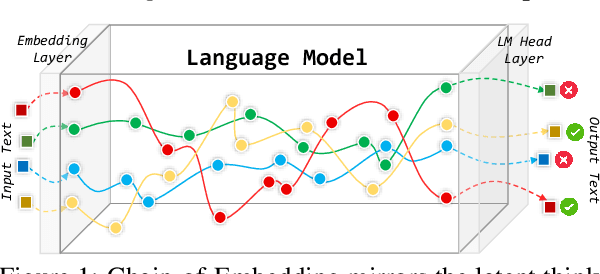
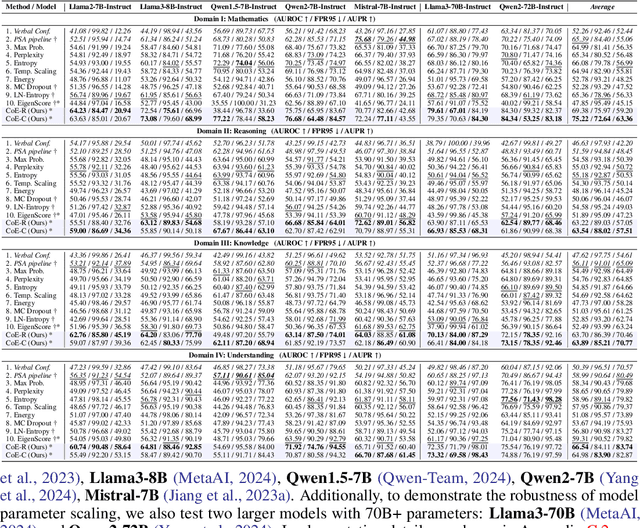


Abstract:LLM self-evaluation relies on the LLM's own ability to estimate response correctness, which can greatly improve its deployment reliability. In this research track, we propose the Chain-of-Embedding (CoE) in the latent space to enable LLMs to perform output-free self-evaluation. CoE consists of all progressive hidden states produced during the inference time, which can be treated as the latent thinking path of LLMs. We find that when LLMs respond correctly and incorrectly, their CoE features differ, these discrepancies assist us in estimating LLM response correctness. Experiments in four diverse domains and seven LLMs fully demonstrate the effectiveness of our method. Meanwhile, its label-free design intent without any training and millisecond-level computational cost ensure real-time feedback in large-scale scenarios. More importantly, we provide interesting insights into LLM response correctness from the perspective of hidden state changes inside LLMs.
Large Language Model for Multi-Domain Translation: Benchmarking and Domain CoT Fine-tuning
Oct 03, 2024



Abstract:Achieving consistent high-quality machine translation (MT) across diverse domains remains a significant challenge, primarily due to the limited and imbalanced parallel training data available in various domains. While large language models (LLMs) have demonstrated impressive general understanding and generation abilities, their potential in multi-domain MT is under-explored. We establish a comprehensive benchmark for multi-domain translation, featuring 25 German$\Leftrightarrow$English and 22 Chinese$\Leftrightarrow$English test sets respectively covering 15 domains. Our evaluation of prominent LLMs reveals a discernible performance gap against traditional MT systems, highlighting domain overfitting and catastrophic forgetting issues after fine-tuning on domain-limited corpora. To mitigate this, we propose a domain Chain of Thought (CoT) fine-tuning technique that utilizes the intrinsic multi-domain intelligence of LLMs to improve translation performance. This method inspires the LLM to perceive domain information from the source text, which then serves as a helpful hint to guide the translation process. Despite being trained on a small dataset of four domains, our CoT fine-tune approach achieves notable enhancements in translation accuracy and domain robustness than traditional fine-tuning, as evidenced by an average 1.53 BLEU score increase in over 20 German$\rightarrow$English distinct out-of-domain tests.
mGTE: Generalized Long-Context Text Representation and Reranking Models for Multilingual Text Retrieval
Jul 29, 2024

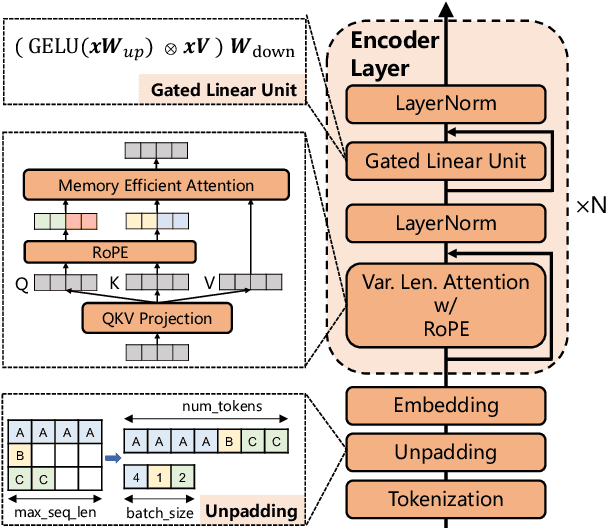
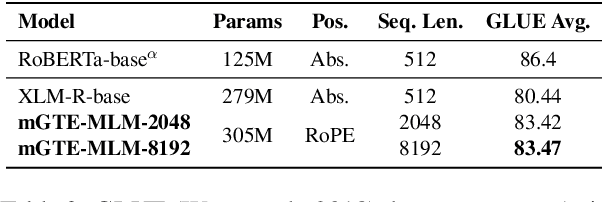
Abstract:We present systematic efforts in building long-context multilingual text representation model (TRM) and reranker from scratch for text retrieval. We first introduce a text encoder (base size) enhanced with RoPE and unpadding, pre-trained in a native 8192-token context (longer than 512 of previous multilingual encoders). Then we construct a hybrid TRM and a cross-encoder reranker by contrastive learning. Evaluations show that our text encoder outperforms the same-sized previous state-of-the-art XLM-R. Meanwhile, our TRM and reranker match the performance of large-sized state-of-the-art BGE-M3 models and achieve better results on long-context retrieval benchmarks. Further analysis demonstrate that our proposed models exhibit higher efficiency during both training and inference. We believe their efficiency and effectiveness could benefit various researches and industrial applications.
Qwen2 Technical Report
Jul 16, 2024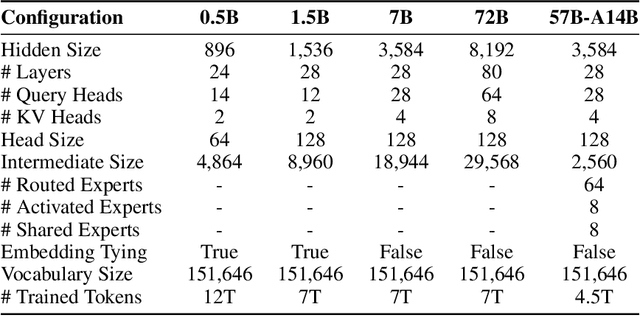
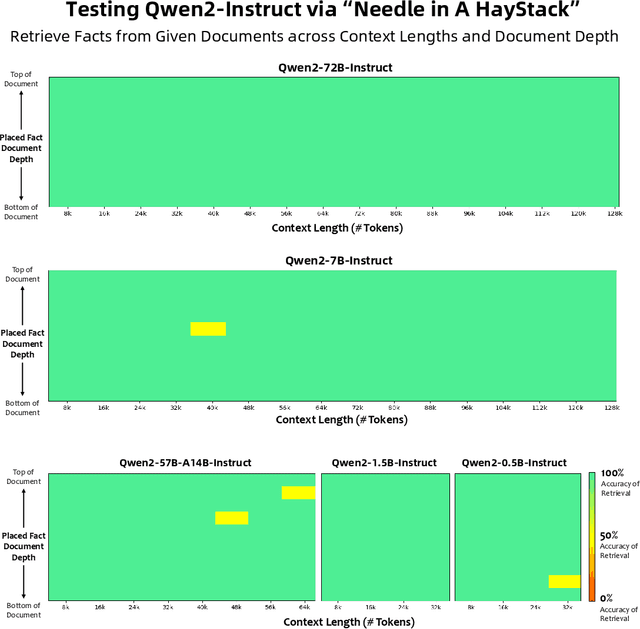
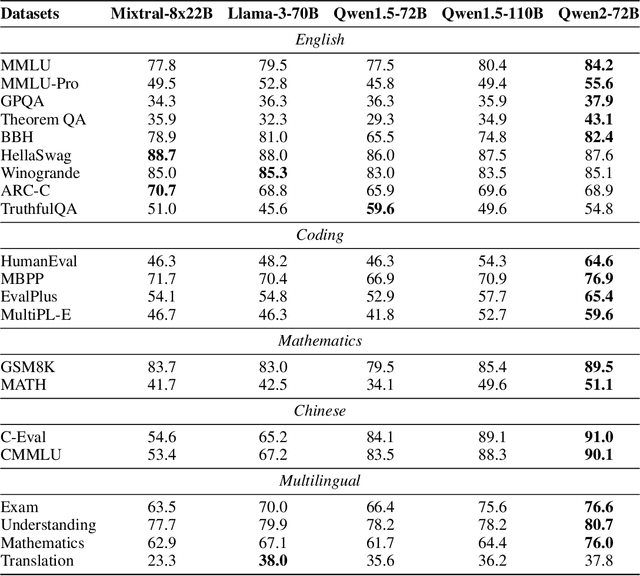
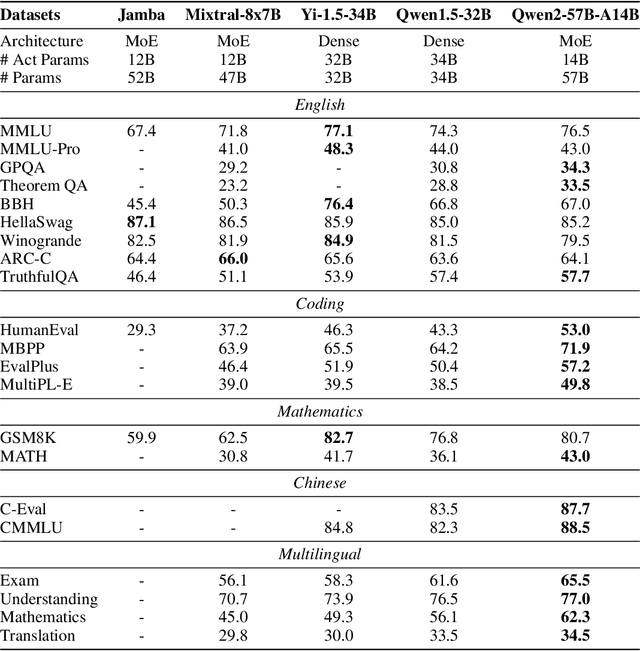
Abstract:This report introduces the Qwen2 series, the latest addition to our large language models and large multimodal models. We release a comprehensive suite of foundational and instruction-tuned language models, encompassing a parameter range from 0.5 to 72 billion, featuring dense models and a Mixture-of-Experts model. Qwen2 surpasses most prior open-weight models, including its predecessor Qwen1.5, and exhibits competitive performance relative to proprietary models across diverse benchmarks on language understanding, generation, multilingual proficiency, coding, mathematics, and reasoning. The flagship model, Qwen2-72B, showcases remarkable performance: 84.2 on MMLU, 37.9 on GPQA, 64.6 on HumanEval, 89.5 on GSM8K, and 82.4 on BBH as a base language model. The instruction-tuned variant, Qwen2-72B-Instruct, attains 9.1 on MT-Bench, 48.1 on Arena-Hard, and 35.7 on LiveCodeBench. Moreover, Qwen2 demonstrates robust multilingual capabilities, proficient in approximately 30 languages, spanning English, Chinese, Spanish, French, German, Arabic, Russian, Korean, Japanese, Thai, Vietnamese, and more, underscoring its versatility and global reach. To foster community innovation and accessibility, we have made the Qwen2 model weights openly available on Hugging Face and ModelScope, and the supplementary materials including example code on GitHub. These platforms also include resources for quantization, fine-tuning, and deployment, facilitating a wide range of applications and research endeavors.
 Add to Chrome
Add to Chrome Add to Firefox
Add to Firefox Add to Edge
Add to Edge